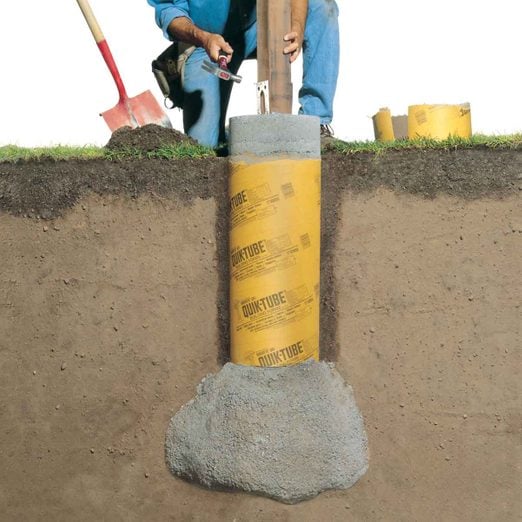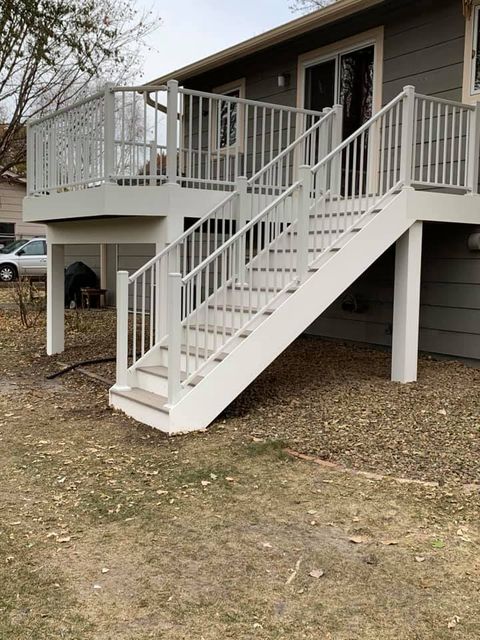Specialist Tips for Putting Up Deck Footings to Support Your Outdoor Room
When it involves developing a deck, among the most crucial elements to think about is the installment of proper grounds. These grounds are the foundation whereupon your exterior area will certainly rest, supplying stability and support for years to come. What exactly does it take to install deck grounds correctly? In this conversation, we will discover professional suggestions and techniques that can assist make certain a successful and resilient deck setup. From picking the appropriate type of footings to staying clear of common mistakes, we will give you with the understanding and insights you need to confidently start your deck-building trip. So, let's dive right in and discover the key to a lasting and strong exterior room.
Relevance of Correct Deck Grounds
Appropriate deck footings are essential for making sure the security and longevity of your outside space. Without solid and appropriately set up grounds, your deck may become unsteady, leading to security hazards and pricey repair work.

Along with security, correct deck footings additionally contribute to the durability of your exterior area (Deck Footings). Footings that are created and created to hold up against the components and dirt problems in your area will certainly assist stop the deck from clearing up or moving gradually. By making certain the grounds are correctly sized and installed, you can decrease the threat of damage to the deck framework, expanding its life-span and minimizing the demand for expensive repair work or replacements

Choosing the Right Kind of Footings
When selecting the proper kind of footings for your deck, it is essential to think about aspects such as soil problems, regional building ordinance, and the general style of your outside room. The kind of footing you select will play a critical role in making sure the stability and durability of your deck.
One usual kind of ground is the concrete ground. Concrete grounds appropriate for many dirt conditions and offer superb support for decks. They are commonly set up listed below the frost line to avoid shifting and working out because of freezing and thawing cycles. One more alternative is helical piers, which are perfect for locations with unpredictable soil or high water tables. These piers are screwed right into the ground and give strong support for the deck.
In many cases, you may require to utilize customized grounds, such as heap grounds or deep structures, if you are building a large or multi-level deck. These grounds are created to distribute the weight of the deck over a larger location, ensuring security and protecting against sinking or settling.
Before picking a sort of footing, it is vital to speak with local building codes and laws to make certain compliance. Furthermore, think about the design and planned usage of your outside area. Elements such as the dimension, shape, and load-bearing demands of your deck will influence the kind of footing that is most appropriate.
Preparing the Ground for Footing Installation
To appropriately prepare the ground for footing setup, it is important to analyze the soil problems and take needed steps to guarantee stability and longevity of the deck. The initial step is to excavate the location where the grounds will be mounted.
When the location has been dug deep into, the following step is to small the dirt. This can be done using a plate compactor or by utilizing a hand meddle. Compacting the dirt aids to eliminate any type of gaps or air pockets, which can lead to working out and instability gradually.
After condensing the dirt, it is essential to lay Click Here a layer of crushed rock or smashed stone at the base of the excavation. This will certainly provide water drainage and assistance to avoid water from merging around the grounds, which can lead to erosion and instability.
Step-by-Step Guide to Putting Up Deck Footings
After properly preparing the ground for footing setup, the following action is to begin the process of setting up deck grounds. This detailed overview will give you with a clear understanding of just how to mount deck grounds for your outdoor room.
Figure out the place: Begin by noting the settings of the deck footings using stakes and string. Make sure that the places line up with the style and layout of your deck.
Dig the openings: Make use of a blog post hole digger or an auger to dig the openings for the footings. The depth and diameter of the openings must remain in conformity with her response neighborhood building regulations and the certain needs of your deck layout.
Degree the openings: Utilize a level to guarantee that the holes are dug to the proper deepness and are degree with each other. (Deck Footings)
Add crushed rock: Location a layer of crushed rock at the end of each hole to improve water drainage and stop the wood from decomposing.
Place the grounds: Place the grounds into the openings, making certain they are level and plumb. Make use of a level and a gauging tape to make certain accuracy.
Protect the footings: Put concrete into the holes around the footings, filling them to the top. Make use of a blog post degree to guarantee the grounds stay level as the concrete collections.
Permit time for healing: Let the concrete cure according to the supplier's directions prior to waging the deck construction.
Common Blunders to Stay Clear Of During Footing Setup
One essential aspect to consider throughout the setup of deck grounds is preventing common mistakes that can endanger the stability and long life of your outside area. While deck footings may feel like a uncomplicated and easy part of the building and construction process, forgeting particular aspects can bring about costly fixings and prospective security hazards down the line.

Additionally, neglecting to set up proper drainage procedures can cause water to gather around the footings, causing rot, decay, and the ultimate weakening of the deck's foundation. Making use of the wrong kind of footing product or failing to appropriately secure the grounds can compromise their architectural honesty.
To avoid these errors, it is necessary to seek advice from with a professional or comply with sector guidelines to guarantee appropriate ground installation. By doing so, you can guarantee the stability and durability of your exterior space, offering a pleasurable and risk-free setting for several years ahead.
Conclusion
Finally, mounting appropriate deck footings is critical for the security and long life of your outdoor area. By selecting the ideal kind of grounds and properly preparing the ground, you can guarantee a strong structure for your deck. Adhering to a detailed overview and preventing usual mistakes throughout footing installation will certainly further boost the longevity and safety and security of your deck.
Correct deck grounds are crucial for ensuring the security and longevity of your outdoor room. The grounds serve as a connection in between the ground and the deck, permitting the weight of the deck and its owners to be spread equally right into the soil.One typical type of ground is the concrete ground. Place the grounds: Position the grounds right into the openings, making sure they are degree and plumb. Protect the grounds: Pour concrete right into the openings around the footings, loading them to the top.